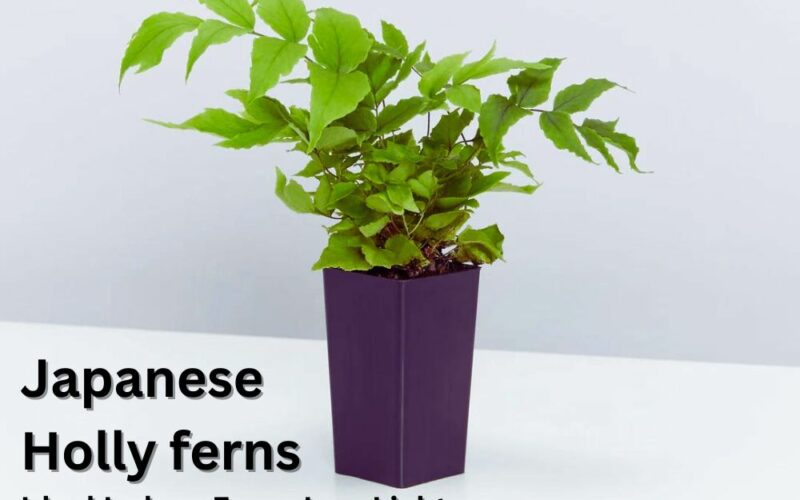I want to gift you unique indoor ferns low light, Japanese holly fern (Cyrtomium falcatum). Cyrtomium falcatum has three varieties that not only offer a beautiful addition to your indoor low light décor, but also are low-maintenance, adaptable, and air-purifying.
The Japanese holly fern (Cyrtomium falcatum) is also known as Miniature Tree fern. I love tropical decors and think this house plant is ideal because provides a touch of elegance to any space, especially in low-light living rooms and brings a breath of fresh air.
In the following, first I will tell you reasons why the Japanese holly fern should be added to your indoor plant collection, then I will give you a comprehensive guideline for caring for your lovely Miniature Tree fern, and finally will tell you pro tips that you must consider them while growing your Japanese holly fern in low light conditions.
If you are ready, let’s get going.
The Best Indoor Ferns Low Light: Facts about Japanese Holly Ferns
The Miniature Tree Fern (Cyrtomium falcatum) offers a compelling combination of attractive features that make it a great addition to your indoor plant collection:
- Easy on the Eyes and Low Maintenance: This fern boasts a unique architectural form with upright, leathery fronds that add a touch of elegance and greenery to any space. Plus, it’s known for being relatively low-maintenance compared to some other ferns, requiring less frequent watering and attention.
- Adapts to Lower Light: Unlike many ferns that demand bright light, the Miniature Tree Fern tolerates lower light conditions better than most. This makes it a viable option for rooms that don’t get a lot of natural sunlight.
- Air-Purifying Powerhouse: This fern acts as a natural air purifier, helping to remove toxins and pollutants from your indoor environment, creating a healthier atmosphere for you to breathe.
- Humidity Booster: While it can adapt to average humidity levels, the Miniature Tree Fern also helps to increase humidity in your home through transpiration (releasing water vapour). This can be beneficial for your health, especially during dry winter months, and can also help other humidity-loving plants in your collection thrive.
- Slow and Steady Growth: If you’re looking for a plant that won’t overcrowd your space quickly, the Miniature Tree Fern is a good choice. Its slow and steady growth habit makes it manageable for smaller homes or apartments.
- Conversation Starter: The unique appearance of the Miniature Tree Fern is sure to spark conversation among guests. Its interesting texture and form can add a touch of the exotic to your indoor décor.
- Prehistoric Connection: The Miniature Tree Fern belongs to the genus Cyrtomium, which has a rich fossil history dating back millions of years. These ferns were once abundant in tropical and subtropical regions during the prehistoric era.
|
Japanese holly ferns are living fossils in your low-light living room, so, can be an attractive topic for a conversation with your guests! By adding a Miniature Tree Fern to your indoor space, you’re not just bringing in a beautiful plant, you’re also bringing in a touch of the ancient tropics! It adds a layer of intrigue and a connection to a bygone era, making your tropical décor even more unique and interesting. |
Pro Tips for Japanese Holly Fern Indoor Care

With its upright fronds and air-purifying properties, the Miniature Tree Fern is a lovely addition to any indoor space. Here are some pro tips to ensure it thrives in your home:
Light:
- Find the sweet spot: While it tolerates lower light, aim for bright indirect light. Avoid direct sunlight, which can scorch the fronds. East or north-facing windows are ideal.
- Rotate your fern regularly: This ensures all sides receive even light and prevents leggy growth towards the light source.
Watering:
- Maintain consistent moisture: Aim for evenly moist soil, but not soggy. Overwatering is a leading cause of fern decline.
- The finger test is your friend: Stick your finger into the soil about an inch deep. If it feels dry, it’s watering time. If it feels moist, wait a few days.
- Water deeply and thoroughly: When watering, soak the soil until water drains freely from the drainage holes. This ensures all the roots get hydrated.
- Empty the drainage tray: Never let your fern sit in water. Empty the drainage tray after watering to prevent root rot.
Humidity:
- Mimic its natural habitat: Miniature Tree Ferns prefer higher humidity levels. Average household humidity might suffice, but here are ways to boost it:
- Group your fern with other plants: Plants naturally transpire moisture, creating a mini-humid microclimate.
- Use a pebble tray: Fill a shallow tray with pebbles and water. Place your fern pot on top (elevated on the pebbles, not directly in the water). As the water evaporates, it increases humidity around the plant.
- Consider a humidifier: If your home has particularly dry air, a humidifier can be a good investment for your fern’s health and other humidity-loving plants.
- Using a spray bottle to mist the leaves regularly can help keep the ferns hydrated and maintain the humidity they need. This method has made a noticeable difference in the health and vibrancy of the ferns. It’s a simple yet effective way to provide them with the moisture they need, especially in drier indoor environments. (Thanks my friend Siam for mentioning this pro tip).
Temperature and Fertilizer:
- Warm and cozy: Maintain temperatures between 60-80°F (15-27°C). Avoid placing your fern near cold drafts, vents, or air conditioners.
- Light feeder: Don’t overdo it! During the growing season (spring and summer), a diluted balanced liquid fertilizer application once a month is sufficient. Skip fertilizing in fall and winter.
Potting and Repotting:
- Well-draining is key: Use a pot with drainage holes to prevent waterlogging.
- Choose the right potting mix: A well-draining, fertile potting mix is ideal. A mix of potting soil, perlite, and some organic matter like compost can work well.
- Repotting on schedule: Repot your fern every 2-3 years, or when the roots outgrow the pot and become pot-bound. Signs of needing a repot include roots circling the drainage holes or the plant pushing itself up out of the pot.
Spring cleaning for your fern:
- In spring, remove any old, faded, or brown fronds. This encourages new, healthy growth and keeps your fern looking its best.
Promote air circulation:
- Good air circulation helps prevent fungal diseases. Make sure your fern isn’t crowded by other plants and has some space around it.
Wipe it down:
- Regularly wipe down the fronds with a damp cloth to remove dust buildup, which can interfere with respiration and make the fern susceptible to pests.
Watch for pests:
- While not as common with ferns, keep an eye out for mealybugs, scale, or aphids. If you see any pests, isolate the fern and treat it with an insecticidal soap solution or neem oil spray.
How to care for Japanese Holly Fern in Low light?
By following the below tips, you can help your Miniature Tree Fern adapt to lower light conditions and continue to thrive in your home. Remember, even though it’s more tolerant of low light, it will still benefit from some brighter indirect light whenever possible.
-
Watering Adjustments:
- Water less frequently: Since low light means less evaporation from the soil, you’ll need to adjust your watering schedule to avoid overwatering.
- Focus on even moisture, not constant moisture: The goal is to keep the soil consistently moist, but not soggy. Allow the top inch of soil to dry out slightly between waterings before watering again.
- Err on the side of underwatering: It’s better to underwater slightly than to overwater your fern in low light. Overwatering can lead to root rot, which is a bigger threat in low-light conditions where the soil dries out slower.
-
Increased Humidity:
- Humidity is even more crucial: Low light can make it harder for the fern to maintain moisture, so increasing humidity becomes even more important.
- Utilize all the humidity boosting methods: Implement all the tips mentioned earlier, like grouping plants, using a pebble tray, or considering a humidifier.
-
Avoid Fertilizing Too Much:
- Fertilizer reduction: Since the fern’s growth will likely be slower in low light, it won’t need as much fertilizer. Reduce your fertilizing frequency to maybe once every two months during spring and summer, and skip fertilizing altogether in fall and winter.
-
Monitor your fern closely:
- Pay closer attention to your fern’s health in low light. Signs of underwatering include wilting fronds and dry soil. Signs of overwatering include mushy or discoloured fronds. Adjust your watering habits based on these observations.
Can All Japanese Holly Fern Varieties Thrive in Low Light?

The Miniature Tree Fern (Cyrtomium falcatum) has a few cultivars (cultivated varieties) with slight variations:
- Cyrtomium falcatum (typical variety): This is the most common type, with upright, glossy, dark green fronds.
- Cyrtomium falcatum ‘Rochford’: This cultivar has slightly wider and more arching fronds compared to the typical variety.
- Cyrtomium falcatum ‘Fortunei’: This cultivar has slightly smaller and more compact fronds compared to the typical variety.
These cultivars might not be as readily available as the standard Cyrtomium falcatum. You might have better luck finding them at specialized plant nurseries or online retailers.
Here’s an additional point to consider:
- Cyrtomium falcatum varieties with variegated foliage: While not technically a variety of Cyrtomium falcatum, some closely related species or hybrids can have variegated foliage (green and white or yellow). However, these tend to be even less common and might require slightly different care, especially regarding light needs.
- Overall, while there are a few cultivars of Cyrtomium falcatum with minor variations, the typical form is the most widely available. If you’re looking for a low-maintenance fern with a unique architectural form, the standard Miniature Tree Fern is a great choice for your indoor space.
- Yes, all the Miniature Tree Fern varieties we discussed, including the typical Cyrtomium falcatum, ‘Rochford’, and ‘Fortunei’, are considered low-light tolerant ferns.
|
It’s important to remember that “low-light tolerant” doesn’t mean they thrive in complete darkness. They will still benefit from some indirect light, even if it’s weaker than what other ferns might require.
Additional things to consider for Japanese Holly Fern varieties in low light:
Variegated foliage: If you encounter a Cyrtomium falcatum variety with variegated foliage (not as common), these might require slightly lighter than the standard green varieties. Variegated plants often need some brighter indirect light to maintain their variegation.
My Additional Care Tips for Japanese Holly Fern:
- You should remove old, faded fronds in spring. It is important to encourage new growth.
- Plants often after reporting become shocked, hence, I recommend repotting only when your fern becomes root bound, I discussed it in my other post.
- I wipe down the fronds of my Cyrtomium falcatum I found it’s important not only to prevent dust buildup but also to early detect of potential diseases.
Conclusion
In this post, I tried to provide a comprehensive guideline for growing Japanese Holly Fern varieties in low-light conditions. I recommend this indoor fern low light plant for all tropical decors. It not only can thrive in low light conditions but also bring fresh air to your dim room.
Do you have experience in caring for indoor ferns? Do you think they are low-maintenance houseplants? What is your favourite low-light hanging plant? Please share your ideas and experiences with us below this page.

Elahe Rabiei
Hi, I’m Elaheh. My Academic major is plant protection, and houseplants are my expertise. As a houseplant lover, my house is full of indoor plants and it is my passion to take care of them. Hence, I’m here to share my knowledge and experience about growing healthy houseplants. I am also a plant protection advisor, so feel free to ask me any questions you may have.


Hey Elahe Rabiei,
You did an excellent job on this post. I really enjoyed reading your post! It was full of great insights. If you don’t mind, I’d like to share an additional tip for anyone caring for indoor ferns in low light.
Using a spray bottle to mist the leaves regularly can help keep the ferns hydrated and maintain the humidity they need. This method has made a noticeable difference in the health and vibrancy of my ferns. It’s a simple yet effective way to provide them with the moisture they need, especially in drier indoor environments.
The people in my community have found this to be helpful, too! Something worth trying.
Have a great day,
Siam
You’re most welcome, Siam!
I’m glad you shared your experience worthwhile. As you mentioned, Japanese Holly ferns thrive in higher humidity environments and regularly misting their leaves with a spray bottle is an excellent solution to maintain optimal moisture levels.
I’ve incorporated your valuable comment into my post.
Thank you for your contribution!
Elahe